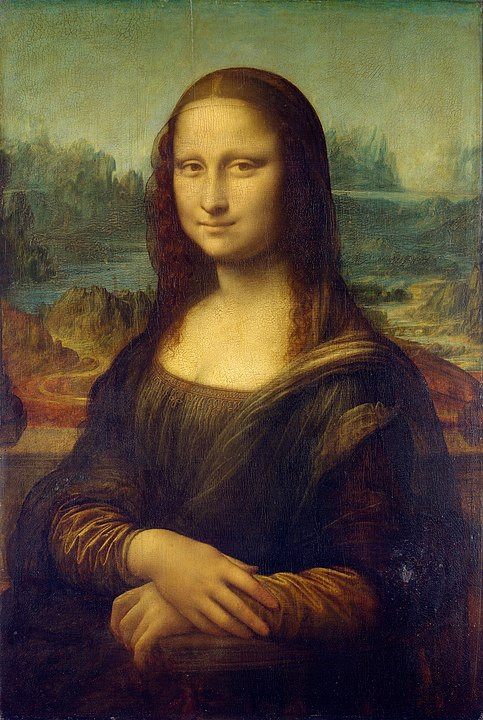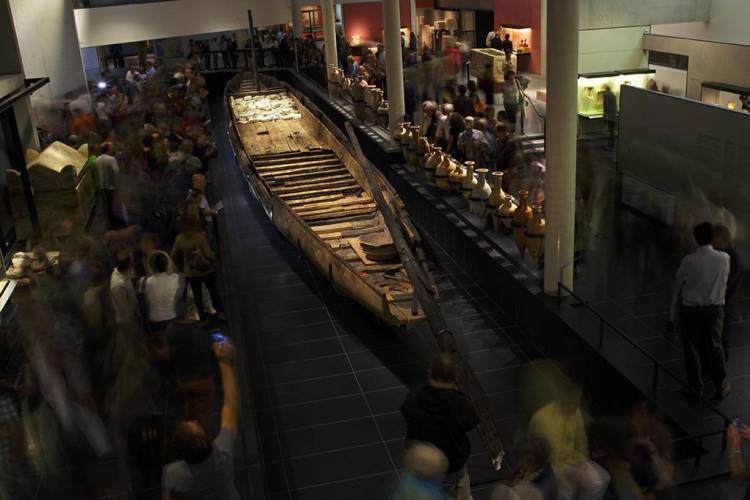Nuclear science and technology are often used in the study and preservation of valuable cultural objects. These objects include everything from paintings, clothing and musical instruments, to statues, arms and armour - even Egyptian mummies and an entire ancient wooden ship. Cultural institutions are increasingly adopting nuclear and related techniques to analyse and protect priceless historical objects and artworks. Nuclear techniques can help unlock hidden drawings which lie beneath the surface of paintings and detect even the most cunning forgeries, all without causing any damage to the object being studied. Techniques such as irradiation also help conserve cultural objects by disinfecting them from microorganisms like bacteria or fungi or by eradicating destructive pests.
1. Characterisation: the study of cultural heritage using nuclear techniques
Characterisation is a process that enables experts to examine the properties of archaeological and art objects with great accuracy, identifying their age, chemical composition and origin. It is not a single method, but rather a multitude of nuclear techniques using diverse types of equipment and radiation, including X-rays, gamma rays, neutrons and ion beams.
Characterisation provides researchers with insights as to when, where and how an item was created. It provides restorers with invaluable information on how to effectively preserve unique archaeological artefacts. It enables specialists to determine whether an art object is authentic or fake and identify whether it has been subject to illicit trade in art. The use of characterisation can also help reveal internal structures, including cracks, fractures and flaws in an artefact, even if they are not visible to the naked eye.
Here is an overview of some of the most common nuclear analytical techniques used for characterisation.
Analysing elemental composition: how X-rays helped unlock the secrets of da Vinci's painting technique

X-ray fluorescence analysis helped experts to better understand da Vinci's painting techniques. (Photo: C2RMF)
One method used to analyse the elemental composition of paintings, manuscripts, coins and ceramics is X-ray fluorescence (XRF) analysis. By exposing a sample to X-rays, scientists cause radiation from chemical elements in the sample to be released. This radiation is unique to each element, enabling the composition of the art item to be accurately established.
In 2010, scientists in France used the XRF method to study the Mona Lisa, a 16th-century masterpiece by the Italian artist Leonardo da Vinci. The researchers analysed the composition and thickness of the different layers of paint and glaze and were able to better understand da Vinci's 'sfumato' technique, which makes the work of art look so lifelike.
Other approaches used to examine the chemical composition and structure of materials include X-ray diffraction (XRD), neutron activation analysis (NAA) and a variety of ion beam methods, such as proton-induced X-ray emission (PIXE), proton-induced gamma-ray emission (PIGE) or accelerator mass spectrometry (AMS). Works of art whose elemental composition was analysed using nuclear techniques include: a 500-year-old golden statue by the sculptor Benvenuto Cellini, the Saliera, stolen and later recovered from the Vienna woods in Austria; a centuries-old portrait of Saint George in Albania; and gold and gemstone artefacts dating back to the Ayutthaya Kingdom that existed in present-day Thailand between the 14th and 18th centuries.
Determining age: how an isotope can help tackle art fraud

An impressionist painting was tested to see whether the piece was a forgery. (Photo: L. Beck/University of Paris-Saclay)
To find out the age of organic materials, including objects made from wood, cotton, paper, leather, wool, silk or bone, scientists can use an approach called radiocarbon dating. All living organisms, such as animals or plants, absorb carbon. When they die, carbon-14, an unstable isotope of carbon, begins to decay at a known rate. Using accelerator mass spectrometry (AMS), specialists measure the ratio of carbon-14 in a piece of art made of organic materials to determine how much time has elapsed since it was created. The technique thus helps determine the age of heritage objects up to 50 000 years old.
By applying radiocarbon dating, in 2019 experts in France were able to prove that two well-known paintings - one Impressionist and one Pointillist - were forgeries. They found that the canvases were manufactured after the 1950s, while the paintings were supposedly created around the turn of the 20th century.
Radiocarbon dating was also applied to determine the age of a bronze statue of the Capitoline Wolf in Italy; a bronze statue of Apoxyomenos found in the waters of the Adriatic Sea off the coast of Croatia; and an ancient aquaculture system in the Country of the Gunditjmara people in Australia.
Seeing inside: how an X-ray scan revealed two hidden Picasso paintings

Two paintings were discovered under 'The Old Guitarist'. (Photo: © 2018 Estate of Pablo Picasso / Artists Rights Society (ARS), New York)
To analyse the internal structure and integrity of cultural heritage objects, scientists use industrial radiography. They pass X-rays, gamma rays or neutrons through an object to see its interior. When the radiation hits an exposed film or specifically designed digital camera placed on the other side, it creates an image of what is hidden from view, including internal defects or cracks.
Moreover, X-rays of paintings often help identify drawings lying underneath. X-ray analysis of Picasso's 'The Old Guitarist' - one of the most famous works of the artist's 'Blue Period' - revealed that he had reused an old canvas. Beneath the paint were two compositions he had made earlier: an older woman with her head bent forward and a young mother with a child kneeling at her side.
Another recent example is the analysis of Vincent van Gogh's painting 'Head of a Peasant Woman' in the UK, which revealed a hidden self-portrait of the artist.
2. Disinfection: removing harmful pests from objects of cultural heritage
Long-term conservation of unique, irreplaceable historical artefacts can be challenging as improper storage conditions can cause bacteria, insects and animals, or mould and fungi to develop on the surface or inside of the artefacts - causing them to deteriorate or even to be completely destroyed. Ionizing radiation can be a solution to this problem because of its capacity to eliminate such pests.
To disinfect objects, experts irradiate them with the help of special equipment, such as high-energy electron beam accelerators, X-ray machines or gamma radiation processing facilities containing either cobalt-60 or caesium-137 radioactive sources. Typically, in a gamma radiation facility, an artefact is brought to the irradiation room. There it is exposed to ionizing radiation and then taken back outside, disinfected and decontaminated.

Disinfecting cultural heritage objects at a gamma irradiation facility. (Graphic: A. Vargas/IAEA)
A famous example of a historical artefact which has been given this treatment is the 3200-year-old mummy of Egyptian Pharaoh Ramses II. It was disinfected in 1977 by gamma irradiation to eliminate insects and fungi at a facility in France. Other examples include books from the Peace Palace Library in the Netherlands, film reels from the National Film Archive of Romania, a baby mammoth found in Siberian permafrost and wooden iconostases in the Holy Voivode of Michael and Gabriel Church in Romania.
Can radiation disinfection harm cultural heritage objects? Do they become radioactive and dangerous to people?
When a substance is exposed to radiation, it receives energy that modifies its structure at the molecular level. But different materials are affected differently depending on the chemical composition, the type of chemical bonds present in the material, the exposure time and the intensity. A properly implemented treatment, while damaging living contaminants and pests, causes no harm to cultural artefacts.
Restorers use small doses of radiation limited to a maximum of 10 kilograys, so the objects of cultural heritage are not damaged. They do not become radioactive after the treatment and cannot irradiate people around them. The objects remain as they were before, only now they are disinfected.
What are the advantages of preserving cultural heritage using irradiation?
Traditionally, experts have used chemical and physical methods to disinfect cultural and historical items. These involve the use of toxic substances or thermal treatments and thus can be harmful to the objects, the restorers or the environment. Both approaches can be expensive. Furthermore, neither of them can guarantee the full eradication of pests if the treatment does not reach the area where the insects or worms have taken up residence.
Applying irradiation techniques has several advantages over traditional methods: they can be used at room temperature without physical contact with the object or the need for any additional substances, and they do not leave traces or cause any damage to the treated materials. Any risks can be minimised by carrying out radiation decontamination in well-protected areas under strict safety conditions.
3. Consolidation: restoring weakened materials in objects of cultural heritage
Irradiation can be used to re-establish the chemical bonds of deteriorated objects, thereby helping to strengthen and solidify artefacts. The method involves soaking the object or material with a liquid resin, and then exposing it to radiation to harden and strengthen it.
With the consolidation method, the appearance of the object remains virtually unchanged, but the material and its physical and chemical properties are transformed in such a way that they become stronger and denser.
For example, in 2011, irradiation was applied to a Roman wooden ship from the first century that had been found in the Rhône River in Arles, France. After the discovery, as the ship was drying, the wood began to crumble. To save the ancient relic, specialists from ARC-Nucléart used the consolidation technique: they impregnated the wood of the ship with a radio-curable resin and exposed it to ionizing radiation to harden the wood and keep the ship from falling apart.

The ancient Roman ship Arles-Rhône 3 at the Departmental Museum of Ancient Arles, France. (Photo: Mdaa/R.Benali/CD13)
What is the role of the IAEA?
- The IAEA's technical cooperation programme provides countries with capacity building for the use of nuclear techniques to study and preserve cultural heritage through training courses, technical meetings, scientific visits and fellowships. The IAEA helps experts around the world with the necessary equipment and facilities to conduct research and implement nuclear interventions. It also supports researchers and conservators by offering harmonised methodologies and standardised procedures.
- The IAEA organizes workshops, conferences and special events on the use of nuclear science and technology for the study and preservation of cultural heritage, facilitating knowledge and experience sharing among international experts.
- The IAEA promotes the publication of academic, research and public information materials on the conservation of cultural heritage. A 2011 publication, Nuclear Techniques for Cultural Heritage Research, offers a comprehensive description of nuclear and related techniques for the analysis, restoration and preservation of historical artefacts and art pieces. A 2017 book, Uses of Ionizing Radiation for Tangible Cultural Heritage Conservation, provides information on radiation disinfection and consolidation and introduces cases of objects treated with irradiation in several countries, including Brazil, Croatia, France, Romania and Tunisia.
- The IAEA designates Collaborating Centres in the area of cultural heritage. There are currently four such centres, including the University Paris-Saclay and ARC-Nucléart in France, the National Centre for Radiation Research and Technology in Egypt and the Australian Nuclear Science and Technology Organisation (ANSTO) in Australia.
- The IAEA offers a variety of training courses and online learning opportunities on the application of nuclear techniques, such as radiocarbon dating for cultural heritage and forensic science, X-ray spectrometry techniques for characterisation of archaeological and art objects and industrial irradiation.






